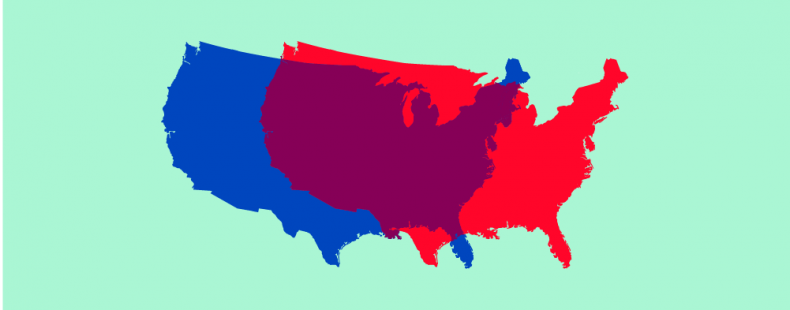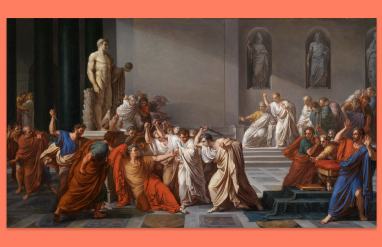If you’ve watched (or even tried to avoid) the news as a presidential election heats up, you’re probably well aware that political pundits like to use the color red to represent the Republican Party and blue for the Democratic Party. A “red state” votes Republican in presidential elections and Senate races, while a “blue state” leans Democratic.
No matter which news program you favor, they all use these same colors to represent the parties. So it would be reasonable to assume these must be the official colors of these two parties and have been used for over a hundred years, right?
Surprisingly … no. Republicans haven’t always been associated with the color red, nor have Democrats affiliated their party with blue. In fact, the whole notion of consistently attaching a particular hue to each political party is a relatively new concept in the US, not emerging as a common distinction until the 2000 presidential election between Democrat and Vice President Al Gore and Republican Texas Governor George W. Bush.
But why red for Republicans? And why does blue stand for Democrats?
Let’s break it down.
How did red and blue come to represent the two major US political parties?
It all started with television. In the early 1970s, networks like ABC, NBC, and CBS were seeking a way to demarcate which states in the electoral college had been won by each candidate. More American households had color TV sets than ever before, giving news programs covering the election an opportunity to show splashy graphics when a state was called in favor of a given candidate.
The first network to color-code states during an election results broadcast was CBS in 1972. However, at that time, blue represented the states won by the Republican incumbent Richard Nixon, and red stood in for those taken by challenger US Senator George McGovern of South Dakota.
There’s a good reason why those colors were chosen for each party at the time: global precedent. In Great Britain, red had long been used to represent the more liberal party, which in this American use case were the Democrats. Blue stood in for Republicans by default, in part because the colors in contrast were striking on screen.
(One rumor, debunked by NBC election unit manager Roy Wetzel, suggested that red was used for Democrats because of some liberal ideologies linking Democrats to Communism.)
But by the late-1980s and early 1990s, those color assignments reversed. Blue became more consistently used for Democrats and red for Republicans.
Nevertheless, it still wasn’t until 2000—the race between Democrat and Vice President Al Gore and Republican Texas Governor George W. Bush—that those colors became synonymous with the name of each party.
How did the 2000 election solidify red for Republican and blue for Democrat?
The 2000 election between Gore and Bush was a momentous event for American politics. The election became a constitutional crisis and dragged on for 36 days, leading to constant television and newspaper coverage of recounts and debates over which candidate won each swing state. Networks “banded together” on their color selection for each party for the purposes of uniformity, choosing red to represent states Bush won, and blue for those Gore won.
It was also during this election that the New York Times and USA Today ran their first full-color electoral state maps featuring red for Republican and blue for Democrat.
Do you know where the Democrat and Republican Parties got their names? Find out here.
But why these particular colors? That’s a difficult question to answer because all news stations want to take credit for what is now the standard.
The credit of the colors rests in part with New York Times graphics editor Archie Tse, who used red for Republicans in 2000 election maps because “red begins with R, Republican begins with R.” Whatever the reason, all of the news outlets certainly played a part in establishing blue and red as the colors when they collectively used them the same way.
While Florida’s votes were being counted, late show host David Letterman joked that perhaps Bush could be “president for the red states” and Gore for the blue. As the Washington Post notes, that punchline was notable in that it prompted the viewer to internalize the color affiliation without its explicit definition.
By the time the election was called for Bush in mid-December, red and blue for Republicans and Democrats, respectively, became canon. They’ve been used as shorthand for the parties ever since, with candidates wearing neckties of the color of their party, and popular election forecaster FiveThirtyEight utilizing the colors to connote which way states might vote.
Which states are considered red and which are blue?
To go along with the colors, the terms “red state” and “blue state” were popularized by anchorman Tim Russert during and immediately after the 2000 election. Today, these terms are used to refer to which party a state voted for during a presidential election.
Generally speaking, the Northeast and the West Coast are considered a collection of blue states as most of them have sided with the Democrats since the early 1990s.
The Southern states (minus Florida and Virginia) have sided with Republicans since the 2000s, while the Midwest tends to be tougher to predict. For example, Illinois and Minnesota are currently considered blue states, while Missouri and Nebraska are red. Hawaii and Alaska have been traditionally considered blue and red respectively as neither has switched parties since the late 1980s (and Alaska has been red since 1968).
The Southwest has been split since 2000 with Nevada, New Mexico, and Colorado going blue more often than red and Utah and Arizona voting predictably red. Finally, we come to the coveted “purple states” or “swing states,” such as Florida, Ohio, Pennsylvania, Iowa, Wisconsin, and Michigan. These states switched colors in recent elections and are often a key focus of electoral campaigning and strategy. Swing states can vary by election year.
Finally, here is a neat bit of trivia: despite the fact that the territory that includes the nation’s capital, the District of Columbia, is not officially recognized as a state it still has three electoral votes. It has cast its three electoral votes for Democrats every single election since it was granted electoral votes in 1962.
WATCH: How To Talk Politics With Your Family Without Arguing
A final word on colors
Many political parties around the world often choose their colors because of their connections to political stances, groups, or ideologies.
For example, red has historically been a color often linked to socialism and communism after a red flag was used by the revolutionaries during the Paris Commune. Revolutionaries may have picked red flags during this time as a possible reference to the 13th century red naval “flags of defiance” that meant a ship would kill any enemy it saw and so was flying a “bloody flag.”
As another example, many environmentalist parties around the world will often use the color green to symbolize nature. Finally, fascist parties have often used the color black such as Adolf Hitler’s Nazi party and Benito Mussolini’s Italian Fascist party because the black color represents what they intend to bring to their enemies: fear, intimidation, and death.
Let’s finish with a quick trip around the globe to see the colors associated with some prominent political parties. In the United Kingdom, the colors are flipped compared to the United States: the right-leaning Conservative Party uses blue and the left-leaning Labour Party uses red. In Canada, Conservatives are blue and Liberals are red. And other parties in other places use colors beyond just red and blue.
- Prepare for more political discourse by understanding the history of the terms left and right in US politics.
- And while you get ready to vote, make sure you have a grasp on the difference between majority and plurality.














